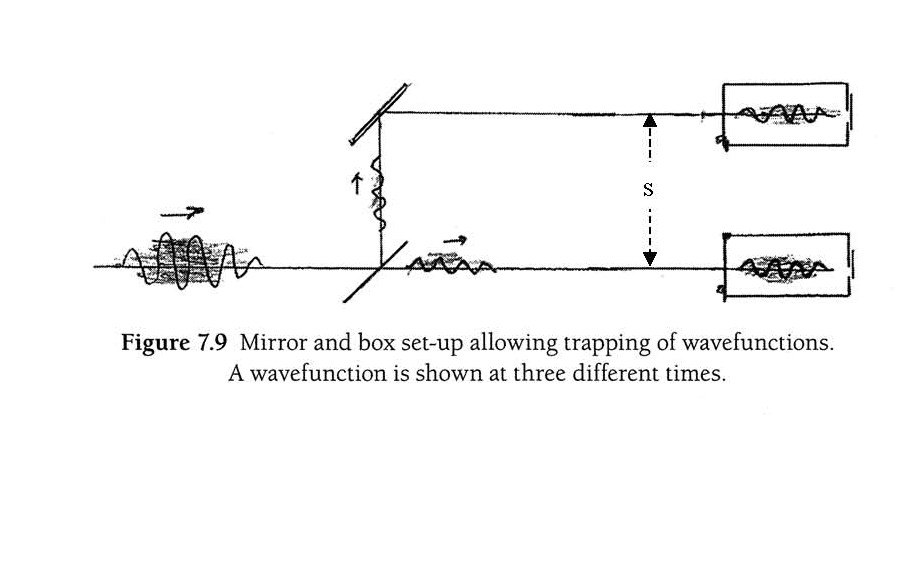Free Choice and Physical Reality
Our book presents a version of the 2-slit experiment emphasizing that the experimental observations themselves (without reference to quantum theory) conflict with any reasonable view of physical reality. Any reasonable view? Well, decide for yourself.
We first describe the experiment for a reader with some background in quantum mechanics. We then give a version independent of any quantum theory. Our book assumes no physics background at all, and is much more reader friendly than this extremely compact description.
A quantum theory description: The 2-slit experiment, most easily done with photons, has also been demonstrated for atoms, and even large molecules. To be general we will refer to an “object.” In principle, only technology limits the size of the object.
A single object, its wavefunction, is directed at the semitransparent mirror as in the figure below. The wavefunction is split equally into a reflected part, directed into the upper box, and a transmitted part directed into the lower box. The doors of the boxes are closed at a time to trap the object’s wavefunction inside the pair of boxes.
A semitransparent mirror for photons is trivial. “Mirrors” also exist for atoms and molecules. A “box” trapping photons while preserving phase is part of any laser. Such boxes for atoms would be difficult, but not impossible. However, our “boxes” need merely be defined regions of space. The “capture” of the object is not a crucial part of the logic, but the confined image dramatizes the situation.
A number of box pairs is prepared as above. Place each box pair, in turn, in the same position, in front of a detection screen, and open a slit in each box at approximately the same time. The wavefunction leaks out of each of the box pairs to collapse on the detection screen and producing an interference pattern. You thus establish that each wavefunction came from both boxes of its pair. (You establish that the object “had been” equally in both boxes of its pair.)
On the other hand, you could have chosen to look in a box of each pair, thus collapsing the wavefunction totally into one box of the pair. (You establish that the object “had been” totally in a single box.) The “contradiction” between these two prior histories constitutes the quantum measurement problem.
A description without reference to quantum theory: You are presented with several sets of box pairs. (They have been prepared as above, but the preparation need not be described.)
You may freely choose to establish that an object was distributed over both boxes of its pair. Or, on the contrary, you may freely choose to establish that the object was concentrated in a single box of its pair. By free choice you can establish either of two contradictory physical situations. Here’s how:
Freely choose a particular set of box pairs from the several sets. Open slits in both boxes of each pair placed in the same position in front of a detection screen. Do this with several freely chosen sets of box pairs with a different spacing “S” of the boxes for each set. You find that the pattern on the detection screen for each set of box pairs, determining where each object was allowed to land, depends on the spacing of the boxes of the box-pair set. Each object therefore “knew” the spacing of its box pair. Therefore something of each object had to have been in both boxes of its pair.
To establish the contradictory situation, that each object was wholly concentrated in a single box, freely choose a box pair set and just look into the boxes. You will find the object entirely concentrated in a single box, and the other box of its pair to be totally empty.
By your free choice of the kind of observation to make, you can establish either of two contradictory prior realities. The quantum experiment (with no need to refer to quantum theory, or even to “interference”) denies the existence of a unique prior physical reality. The prior reality depends on your free choice. No “reasonable” view of physical reality would seem to account for this.
In our book, this enigma is displayed in a dialog between a physicist and a Group of Reasonable and Open-minded PEople (the “GROPE”). It forms the major part of an entire chapter.
